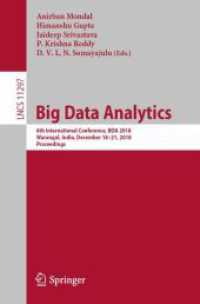- ホーム
- > 洋書
- > 英文書
- > Computer / Languages
Full Description
Dart is a class-based, object-oriented language that simplifies the development of structured modern apps, scales from small scripts to large applications, and can be compiled to JavaScript for use in any modern browser. In this rigorous but readable introductory text, Dart specification lead Gilad Bracha fully explains both the language and the ideas that have shaped it.The Dart Programming Language offers an authoritative description of Dart for programmers, computer science students, and other well-qualified professionals. The text illuminates key programming constructs with significant examples, focusing on principles of the language, such as optional typing and pure object-orientation.Bracha thoroughly explains reflection in Dart, showing how it is evolving into a form that programmers can easily apply without creating excessively large programs. He also shares valuable insights into Dart's actor-style model for concurrency and asynchronous programming. Throughout, he covers both language semantics and the rationale for key features, helping you understand not just what Dart does, but why it works the way it does.You will learn aboutDart's object model, in which everything is an object, even numbers and Boolean values How Dart programs are organized into modular libraries How Dart functions are structured, stored in variables, passed as parameters, and returned as results Dart's innovative approach to optional typing How Dart handles expressions and statements How to use Dart's implementation of reflection to introspect on libraries, classes, functions, and objects Isolates and other Dart features that support concurrency and distributionRegister your product at informit.com/register for convenient access to downloads, updates, and corrections as they become available.
Contents
Foreword xiPreface xvAcknowledgments xviiAbout the Author xixChapter 1: Introduction 11.1 Motivation 11.2 Design Principles 21.3 Constraints 41.4 Overview 41.5 Book Structure 101.6 Related Work and Influences 10Chapter 2: Objects, Interfaces, Classes and Mixins 132.1 Accessors 142.2 Instance Variables 172.3 Class Variables 172.4 Finals 182.5 Identity and Equality 192.6 Class and Superclass 212.7 Abstract Methods and Classes 222.8 Interfaces 232.9 Life of an Object 242.10 noSuchMethod() 302.11 Constant Objects and Fields 312.12 Class Methods 322.13 Instances, Their Classes and Metaclasses 332.14 Object and Its Methods 342.15 Mixins 362.16 Related Work 452.17 Summary 46Chapter 3: Libraries 473.1 The Top Level 473.2 Scripts 483.3 Privacy 483.4 Imports 493.5 Breaking Libraries into Parts 533.6 Exports 553.7 Diamond Imports 563.8 Deferred Loading 573.9 Related Work 583.10 Summary 59Chapter 4: Functions 614.1 Parameters 614.2 Function Bodies 634.3 Function Declarations 644.4 Closures 654.5 Invoking Methods and Functions 664.6 The Function Class 684.7 Functions as Objects 694.8 Generator Functions 714.9 Related Work 744.10 Summary 74Chapter 5: Types 755.1 Optional Typing 755.2 A Tour of Types 775.3 Interface Types 795.4 Types in Action: The Expression Problem, Typed 825.5 Generics 855.6 Function Types 915.7 Type Rei_cation 955.8 Malformed Types 1025.9 Unsoundness 1045.10 Related Work 1065.11 Summary 107Chapter 6: Expressions and Statements 1096.1 Expressions 1096.2 Statements 1256.3 Summary 137Chapter 7: Reflection 1397.1 Introspection 1397.2 Why Mirrors 1657.3 Metadata 1657.4 Reflection via Code Generation 1667.5 Beyond Introspection 1697.6 Related Work 1697.7 Summary 170Chapter 8: Asynchrony and Isolates 1718.1 Asynchrony 1718.2 Futures 1728.3 Streams 1748.4 Isolates 1758.5 Example: Client-Server Communication 1778.6 Asynchronous Functions 1838.7 Related Work 1858.8 Summary 185Chapter 9: Conclusion 1879.1 Optional Typing 1879.2 Object Orientation 1889.3 Reflection 1889.4 Tooling 1899.5 Summary 189Bibliography 191Index 195







